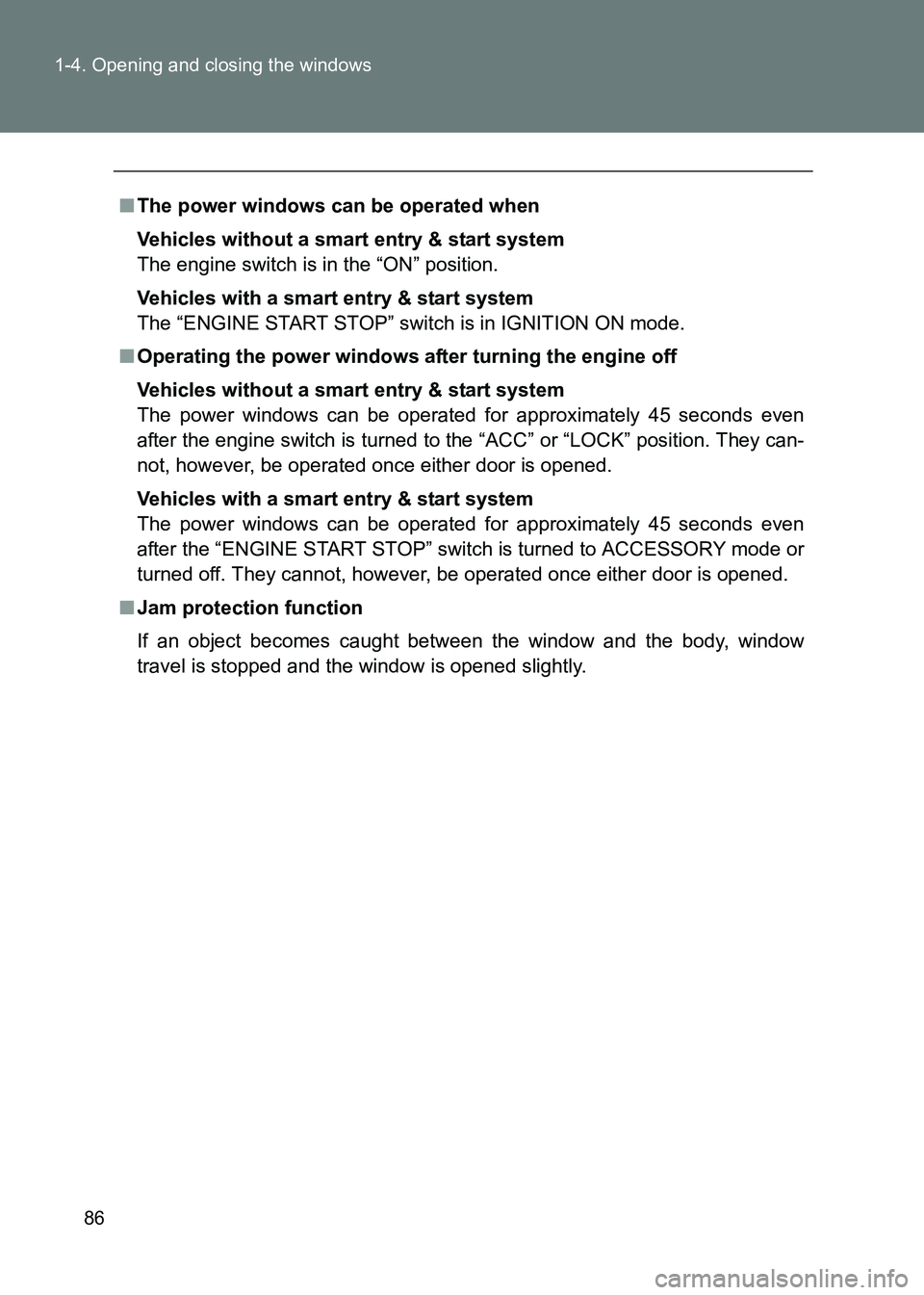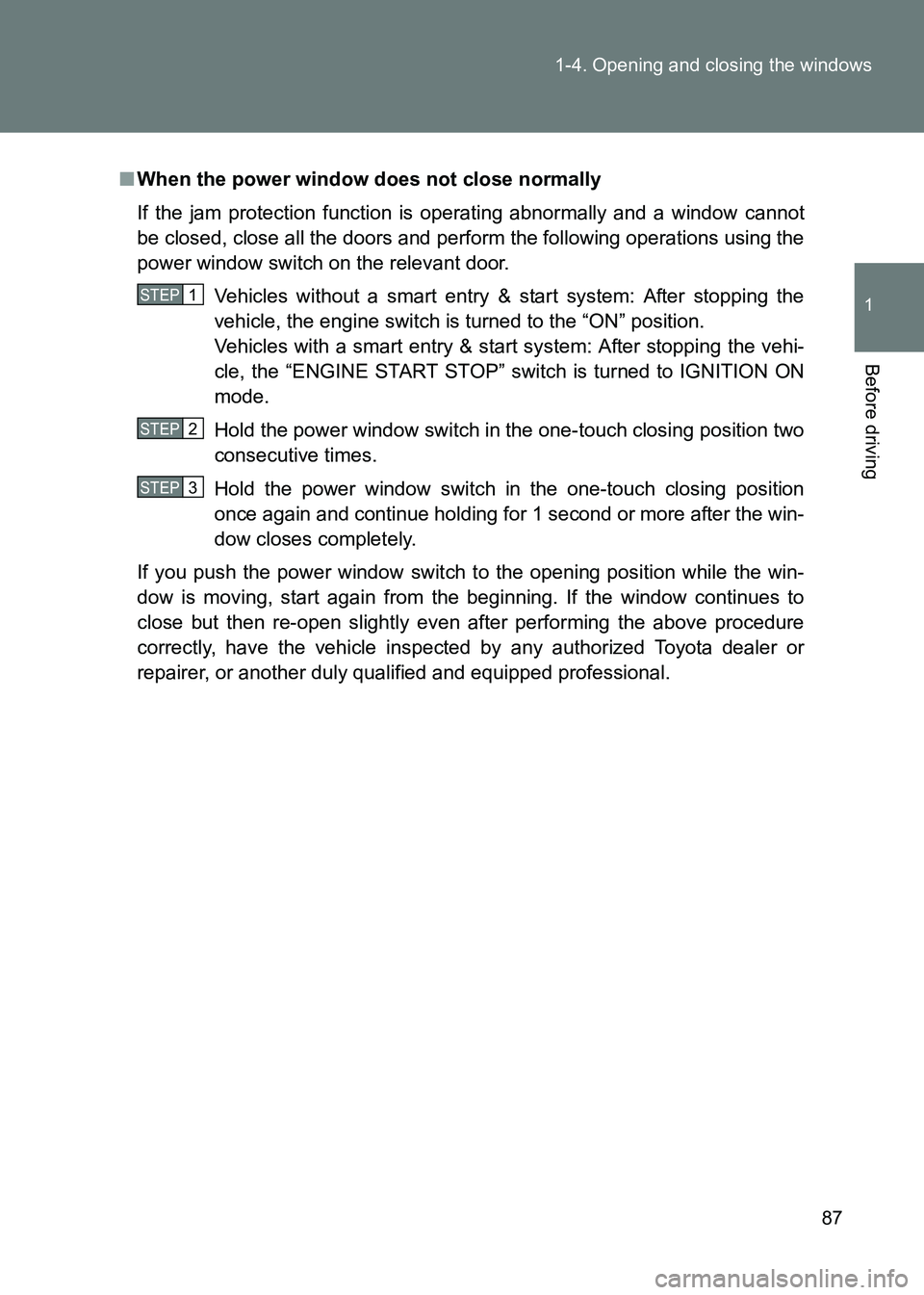2017 TOYOTA GT86 ECO mode
[x] Cancel search: ECO modePage 40 of 505

40
1-2. Opening, closing and locking the doors and trunk
86_EE (OM18071E)
■
Security feature
If a door is not opened within approximately 30 seconds after the vehicle is
unlocked, the security feature automatically locks the vehicle again. (How-
ever, depending on the location of the electronic key, the key may be
detected as being in the vehicle. In this case, the vehicle may be unlocked.)
■ Battery-saving function
The battery-saving function will be activated in order to prevent the elec-
tronic key battery and the vehicle battery from being discharged while the
vehicle is not in operation for a long time.
●In the following situations, the smart entry & start system may take some
time to unlock the doors.
• The electronic key has been left in an area of approximately 2 m (6 ft.)
of the outside of the vehicle for 10 minutes or longer.
• The smart entry & start system has not been used for 5 days or longer.
● If the smart entry & start system has not been used for 14 days or longer,
the doors cannot be unlocked at any doors except the driver’s door.
In this case, take hold of the driver’s door handle, or use the wireless
remote control or the mechanical key, to unlock the doors.
AlarmSituationCorrection procedure
Interior alarm
sounds continu-
ously The “ENGINE START
STOP” switch was turned
to ACCESSORY mode
while the driver’s door was
open (or the driver’s door
was opened while the
“ENGINE START STOP”
switch was in ACCES-
SORY mode). Turn the “ENGINE
START STOP” switch
off and close the
driver’s door.
Page 42 of 505

42
1-2. Opening, closing and locking the doors and trunk
86_EE (OM18071E)
■
Notes for the entry function
●Even when the electronic key is within the effective range (detection
areas), the system may not operate properly in the following cases:
• The electronic key is too close to the window or outside door handle,
near the ground, or in a high place when the doors are locked or
unlocked.
• The electronic key is near the ground or in a high place, or too close to the rear bumper center when the trunk is unlocked.
• The electronic key is on the instrument panel, rear package tray or floor, in the door pockets or glove box or auxiliary box when the engine
is started or “ENGINE START STOP” switch modes are changed.
● Do not leave the electronic key on top of the instrument panel or near the
door pockets when exiting the vehicle. Depending on the radio wave
reception conditions, it may be detected by the antenna outside the cabin
and the door will become lockable from the outside, possibly trapping the
electronic key inside the vehicle.
● As long as the electronic key is within the effective range, the doors may
be locked or unlocked by anyone.
● Even if the electronic key is not inside the vehicle, it may be possible to
start the engine if the electronic key is near the window.
● The doors may unlock if a large amount of water splashes on the door
handle, such as in the rain or in a car wash when the electronic key is
within the effective range. (The door will automatically be locked after
approximately 30 seconds if the doors are not opened and closed.)
● Gripping the door handle when wearing a glove may not unlock the door.
● If the wireless remote control is used to lock the doors when the elec-
tronic key is near the vehicle, there is a possibility that the door may not
be unlocked by the entry function. (Use the wireless remote control to
unlock the doors.)
● A sudden approach to the effective range or door handle may prevent the
doors from being unlocked. In this case, return the door handle to the
original position and check that the doors unlock before pulling the door
handle again.
Page 45 of 505

45
1-2. Opening, closing and locking the doors and trunk
1
Before driving
86_EE (OM18071E)
■
Electronic key battery depletion
●The standard battery life is 1 to 2 years.
● If the battery charge becomes low, a buzzer will sound in the cabin and a
message will be displayed on the multi-information display when the
engine is stopped. ( →P. 411)
● As the electronic key always receives radio waves, the battery will
become depleted even if the electronic key is not used. The following
symptoms indicate that the electronic key battery may be depleted.
Replace the battery when necessary. ( →P. 360)
• The smart entry & start system or the wireless remote control does not operate.
• The detection area becomes smaller.
• The LED indicator on the key surface does not turn on.
● To avoid serious deterioration, do not leave the electronic key close to
any of the following electrical app liances that produce a magnetic field:
•TVs
• Personal computers
• Cellular phones, cordless phones and battery chargers
• Recharging cellular phones or cordless phones
• Induction cookers
• Table lamps
■ When the electronic key battery is fully depleted
→ P. 360
■ If the smart entry & start system h as been deactivated in a customized
setting
● Locking and unlocking the doors, unlocking the trunk: Use the wireless
remote control or mechanical key. ( →P. 52, 455)
● Starting the engine and changing “ENGINE START STOP” switch
modes: →P. 456
● Stopping the engine: →P. 458
■ Customization that can be configured at any authorized Toyota dealer
or repairer, or another duly qualified and equipped professional
Settings (e. g. smart entry & start system) can be changed.
(Customizable features: →P. 487)
Page 86 of 505

86
1-4. Opening and closing the windows
86_EE (OM18071E)
■
The power windows can be operated when
Vehicles without a smart entry & start system
The engine switch is in the “ON” position.
Vehicles with a smart entry & start system
The “ENGINE START STOP” switch is in IGNITION ON mode.
■ Operating the power windows after turning the engine off
Vehicles without a smart entry & start system
The power windows can be operated for approximately 45 seconds even
after the engine switch is turned to the “ACC” or “LOCK” position. They can-
not, however, be operated once either door is opened.
Vehicles with a smart entry & start system
The power windows can be operated for approximately 45 seconds even
after the “ENGINE START STOP” switch is turned to ACCESSORY mode or
turned off. They cannot, however, be operated once either door is opened.
■ Jam protection function
If an object becomes caught between the window and the body, window
travel is stopped and the window is opened slightly.
Page 87 of 505

87
1-4. Opening and closing the windows
1
Before driving
86_EE (OM18071E)
■
When the power window does not close normally
If the jam protection function is operating abnormally and a window cannot
be closed, close all the doors and perform the following operations using the
power window switch on the relevant door.
Vehicles without a smart entry & start system: After stopping the
vehicle, the engine switch is turned to the “ON” position.
Vehicles with a smart entry & st art system: After stopping the vehi-
cle, the “ENGINE START STOP” switch is turned to IGNITION ON
mode.
Hold the power window switch in the one-touch closing position two
consecutive times.
Hold the power window switch in the one-touch closing position
once again and continue holding for 1 second or more after the win-
dow closes completely.
If you push the power window switch to the opening position while the win-
dow is moving, start again from the beginning. If the window continues to
close but then re-open slightly even after performing the above procedure
correctly, have the vehicle inspected by any authorized Toyota dealer or
repairer, or another duly qualified and equipped professional.
STEP 1
STEP 2
STEP 3
Page 113 of 505

113
1-7. Safety information
1
Before driving
86_EE (OM18071E)
SRS front airbag
The driver’s SRS front ai
rbag is stowed in the cent er portion of the steering
wheel. The driver’s knee airbag is stowed under the steering column. The
passenger’s SRS front airbag is stowed near the top of the dashboard under
an “SRS AIRBAG” mark.
In a moderate to severe front collision, the following components deploy.
● SRS front airbag for driver
● SRS front airbag for front passenger
● Knee airbag for driver
These components supplement the seat belts by reducing the impact to the
occupant’s head, chest and knees.
■ If the SRS airbags deploy (inflate)
●Slight abrasions, burns, bruising etc., may be sustained from SRS air-
bags, due to the extremely high speed deployment (inflation) by hot
gases.
● A loud noise and white powder will be emitted.
● Parts of the airbag module (steering wheel hub, airbag cover and inflator)
as well as the front seats, parts of the front and rear pillars, and roof side
rails, may be hot for several minutes. The airbag itself may also be hot.
● The windshield may crack.
■ Front-seat passenger airbag manual cut off switch
The passenger-side front airbag can be deactivated by the cut off switch
located in the instrumental panel side. When the cut off switch is turned to
the deactivation mode the passenger-s ide front airbag becomes deacti-
vated. When the cutoff switch is turned to the activation mode the passen-
ger-side front airbag becomes active to deploy. While the passenger-side
front airbag is active the A/B ON indicator is illuminated.
Page 133 of 505

133
1-7. Safety information
1
Before driving
86_EE (OM18071E)
SRS airbag system monitor
■ SRS warning light
A diagnostic system continually
monitors the readiness of the
SRS airbag system (including
front seat belt pretensioners)
while the vehicle is being driven.
The SRS warning light will show
normal system operation by illu-
minating for approximately 6
seconds when the engine switch
is turned to the “ON” position
(vehicles without a smart entry &
start system), or the “ENGINE
START STOP” switch is turned
to IGNITION ON mode (vehicles
with a smart entry & start sys-
tem).
The following components are monitored by the indicator.
● Front sub sensor
• Right-hand side
• Left-hand side
● Airbag control module (including impact sensor)
● Front airbag module
• Driver’s side
• Front passenger’s side
● Knee airbag module (driver’s side)
Vehicles with a monochrome multi-
information display
Vehicles with a color multi-information
display
Page 135 of 505

135
1-7. Safety information
1
Before driving
86_EE (OM18071E)
WARNING
■
SRS warning light
If the warning light exhibits any of the following conditions, there may be a
malfunction in the seat belt pretensioners and/or SRS airbag system. We
recommend that you have the system checked immediately by your nearest
any authorized Toyota dealer or re pairer, or another duly qualified and
equipped professional. Unless checked and properly repaired, the seat belt
pretensioners and/or SRS airbags will operate improperly (e.g. SRS airbags
may inflate in a very minor collision or not inflate in a severe collision), which
may increase the risk of injury.
● Flashing or flickering of the warning light
● No illumination of the warning light when the engine switch is first turned to
the “ON” position (vehicles without a smart entry & start system), or the
“ENGINE START STOP” switch is turned to IGNITION ON mode (vehicles
with a smart entry & start system).
● Continuous illumination of the warning light
● Illumination of the warning light while driving